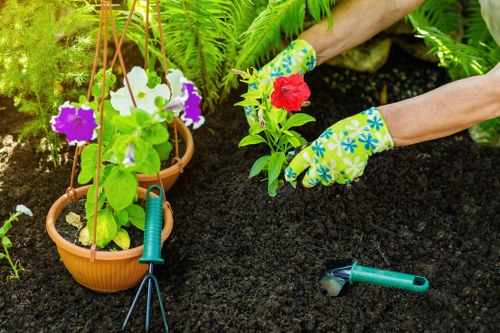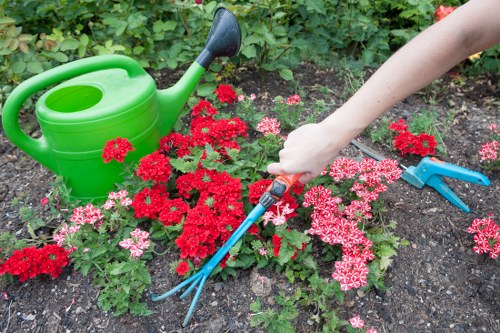Tree Lopping and Removal in Temple

The Importance of Tree Maintenance in Temples
Trees have been an integral part of temple complexes for centuries, providing not only aesthetic beauty but also spiritual significance. Maintaining these trees through tree lopping and removal is essential to preserve the sanctity and safety of the temple environment.
Overgrown or unhealthy trees can pose risks such as falling limbs or structural damage to the temple buildings. Regular tree maintenance ensures that the sacred space remains both beautiful and safe for worshippers and visitors alike.
Additionally, well-maintained trees contribute to a serene ambiance, enhancing the overall experience of those who come to seek peace and solace within the temple grounds.

When is Tree Lopping Necessary?
Determining the right time for tree lopping and removal is crucial to maintaining the temple’s landscape. Several factors should be considered to ensure that the process is both effective and respectful of the sacred environment.
- Tree Health: Assessing the health of the tree is the first step. Diseased or dying trees should be removed promptly to prevent the spread of pests and diseases.
- Safety Concerns: Trees that pose a safety hazard, such as those with weak branches or those too close to temple structures, require immediate attention.
- Space Management: As temples expand or change, certain trees may need to be removed to accommodate new structures or pathways.
- Environmental Impact: Considering the ecological balance, the removal should minimize disruption to local wildlife and plant life.
By carefully evaluating these factors, temple authorities can make informed decisions regarding tree maintenance, ensuring both safety and environmental stewardship.
Proper timing also ensures that tree removal does not interfere with temple activities, festivals, or important religious ceremonies.

Methods of Tree Lopping and Removal
There are various methods employed in tree lopping and removal, each suited to different situations and types of trees. Understanding these methods helps in selecting the most appropriate technique for the temple grounds.
- Pruning: This involves trimming the branches to remove dead or overgrown limbs, promoting healthier growth and maintaining the tree's shape.
- Selective Thinning: Removing certain branches to reduce the tree's density, which enhances air circulation and sunlight penetration.
- Complete Removal: In cases where the tree is beyond saving or poses significant risks, complete removal is necessary.
- Stump Grinding: After removal, grinding the stump ensures that it does not become a breeding ground for pests or interfere with temple activities.
Each method requires expertise to ensure that the tree's integrity is preserved as much as possible and that the surrounding environment remains undisturbed.
Professional arborists are often employed to carry out these tasks, ensuring that the removal process adheres to safety standards and minimizes impact on the temple grounds.

Choosing the Right Professionals
Selecting experienced and reputable professionals for tree lopping and removal is crucial for the success of the project. The right team ensures that the work is carried out efficiently, safely, and with respect for the temple’s sacred environment.
- Certification and Training: Ensure that the arborists are certified and have undergone proper training in tree maintenance and safety protocols.
- Experience: Look for professionals with extensive experience in working with similar environments, particularly in temple or historical sites.
- References and Reviews: Checking references and reviews can provide insights into the reliability and quality of the service provider.
- Insurance: Verify that the company has adequate insurance coverage to protect against any potential damages or accidents during the process.
Working with the right professionals not only ensures the quality of work but also brings peace of mind, knowing that the sacred temple grounds are in capable hands.
Additionally, a professional team can offer guidance on best practices for tree maintenance, contributing to the long-term health and beauty of the temple’s flora.

Environmental Considerations
Environmental stewardship is a key aspect of tree lopping and removal in temple settings. Balancing the need for maintenance with ecological responsibility ensures that the natural beauty and biodiversity of the temple grounds are preserved.
- Sustainable Practices: Implementing sustainable methods, such as using eco-friendly tools and minimizing waste, helps reduce the environmental footprint of the removal process.
- Replanting: After removal, replanting native species can maintain the ecological balance and enhance the temple’s natural landscape.
- Wildlife Preservation: Ensuring that removal activities do not disrupt local wildlife habitats is essential for maintaining biodiversity.
- Soil Health: Protecting the soil from erosion and contamination during removal preserves the integrity of the temple grounds.
By incorporating these environmental considerations, temples can uphold their role as guardians of both spiritual and natural heritage.
Moreover, sustainable tree management practices contribute to the overall health and longevity of the temple’s surrounding environment.

Permits and Regulations
Complying with local permits and regulations is a critical aspect of tree lopping and removal in temple areas. Adhering to legal requirements ensures that the process is conducted responsibly and ethically.
- Local Laws: Understanding and following local ordinances related to tree removal is essential to avoid legal complications.
- Permits: Securing the necessary permits before commencing work ensures that the removal is authorized and compliant with regulations.
- Protected Species: Identifying and protecting any trees that are classified as protected or endangered is crucial to comply with environmental laws.
- Documentation: Keeping detailed records of the removal process and permits obtained provides transparency and accountability.
Working closely with local authorities and environmental agencies can facilitate a smooth and lawful tree removal process.
Additionally, understanding the cultural and historical significance of certain trees within the temple can influence the approach to their maintenance or removal.

Cost Considerations
The cost of tree lopping and removal can vary based on several factors, including the size of the tree, its location, and the complexity of the job. Proper budgeting ensures that the temple can allocate resources effectively for maintenance.
- Tree Size and Species: Larger trees or those with complex root systems may require more resources and specialized equipment.
- Accessibility: Trees located in hard-to-reach areas may increase the difficulty and cost of removal.
- Health of the Tree: Diseased or damaged trees may require additional steps, such as treating the area post-removal to prevent disease spread.
- Disposal Fees: Proper disposal of the removed tree material can add to the overall cost.
Obtaining multiple quotes from reputable service providers can help the temple find a balance between cost and quality of service.
Investing in regular maintenance can also reduce long-term costs by preventing more extensive and expensive removal efforts in the future.

The Spiritual Significance of Trees in Temples
Trees hold profound spiritual significance in many religious traditions, including those practiced in temples. Understanding this importance helps guide respectful and considerate tree maintenance practices.
- Symbolism: Trees often symbolize life, growth, and connection to the divine, making their presence in temples meaningful.
- Rituals and Offerings: Many traditions incorporate trees into rituals, using them as sites for offerings or meditative practices.
- Environmental Harmony: Trees represent harmony with nature, a core principle in many spiritual teachings.
- Legacy: Preserving certain trees can honor historical and cultural legacies associated with the temple.
Respecting the spiritual roles of trees ensures that maintenance efforts align with the temple’s religious values and enhance the worship experience.
When trees are removed or maintained, it is important to do so in a manner that upholds their sacred significance, possibly incorporating rituals or acknowledgments during the process.

Benefits of Professional Tree Removal
Engaging professionals for tree lopping and removal offers numerous benefits that go beyond basic maintenance. Professional services bring expertise, efficiency, and assurance to the process.
- Expertise: Trained arborists understand the biology and structure of trees, allowing for informed decisions regarding their care.
- Safety: Professionals adhere to safety protocols to protect both the workers and the temple property during the removal process.
- Efficiency: Experienced teams can complete the job more quickly and effectively, minimizing disruption to temple activities.
- Proper Equipment: Having access to the right tools and machinery ensures that the job is done correctly and with minimal impact on the surroundings.
By leveraging professional services, temples can ensure that their trees are maintained in a manner that supports both their physical and spiritual well-being.
Additionally, professionals can provide valuable advice on future tree care and maintenance, fostering a sustainable approach to the temple’s landscape management.

Conclusion
Effective tree lopping and removal in temple settings is essential for maintaining the beauty, safety, and spiritual atmosphere of these sacred spaces. By understanding the importance of tree maintenance, choosing the right professionals, and adhering to environmental and regulatory standards, temples can ensure their landscapes remain harmonious and inviting.
Regular upkeep not only preserves the physical integrity of the temple grounds but also honors the spiritual significance of the trees that enrich the worship experience.
Contact us today to learn more about our specialized tree maintenance services tailored for temple environments. Let us help you preserve the sanctity and beauty of your sacred space.